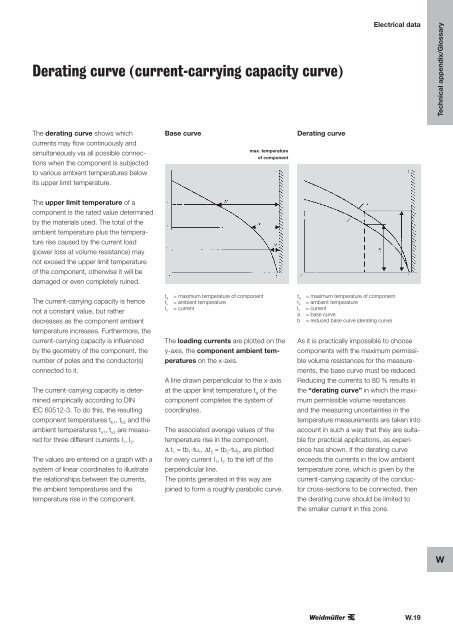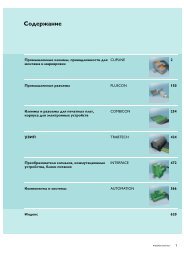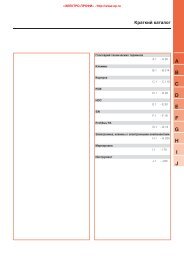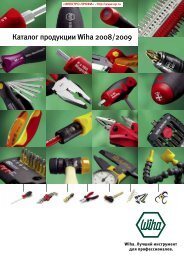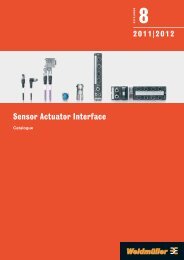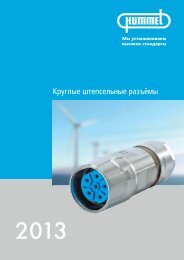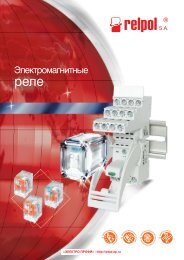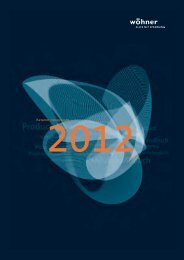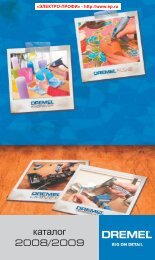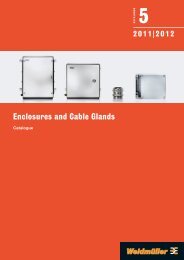ÐаÑалог Weidmuller: Electronics - Analogue Signal Conditioning
ÐаÑалог Weidmuller: Electronics - Analogue Signal Conditioning
ÐаÑалог Weidmuller: Electronics - Analogue Signal Conditioning
Create successful ePaper yourself
Turn your PDF publications into a flip-book with our unique Google optimized e-Paper software.
Derating curve (current-carrying capacity curve)<br />
Electrical data<br />
Technical appendix/Glossary<br />
The derating curve shows which<br />
currents may flow continuously and<br />
simultaneously via all possible connections<br />
when the component is subjected<br />
to various ambient temperatures below<br />
its upper limit temperature.<br />
Base curve<br />
max. temperature<br />
of component<br />
Derating curve<br />
The upper limit temperature of a<br />
component is the rated value determined<br />
by the materials used. The total of the<br />
ambient temperature plus the temperature<br />
rise caused by the current load<br />
(power loss at volume resistance) may<br />
not exceed the upper limit temperature<br />
of the component, otherwise it will be<br />
damaged or even completely ruined.<br />
The current-carrying capacity is hence<br />
not a constant value, but rather<br />
decreases as the component ambient<br />
temperature increases. Furthermore, the<br />
current-carrying capacity is influenced<br />
by the geometry of the component, the<br />
number of poles and the conductor(s)<br />
connected to it.<br />
The current-carrying capacity is determined<br />
empirically according to DIN<br />
IEC 60512-3. To do this, the resulting<br />
component temperatures t b1 , t b2 and the<br />
ambient temperatures t u1 , t u2 are measured<br />
for three different currents I 1 , I 2 .<br />
The values are entered on a graph with a<br />
system of linear coordinates to illustrate<br />
the relationships between the currents,<br />
the ambient temperatures and the<br />
temperature rise in the component.<br />
t g = maximum temperature of component<br />
t u = ambient temperature<br />
I n = current<br />
The loading currents are plotted on the<br />
y-axis, the component ambient temperatures<br />
on the x-axis.<br />
A line drawn perpendicular to the x-axis<br />
at the upper limit temperature t g of the<br />
component completes the system of<br />
coordinates.<br />
The associated average values of the<br />
temperature rise in the component,<br />
Δ t 1 = tb 1 -tu 1 , Δt 2 = tb 2 -tu 2 , are plotted<br />
for every current I 1 , I 2 to the left of the<br />
perpendicular line.<br />
The points generated in this way are<br />
joined to form a roughly parabolic curve.<br />
t g = maximum temperature of component<br />
t u = ambient temperature<br />
I n = current<br />
a = base curve<br />
b = reduced base curve (derating curve)<br />
As it is practically impossible to choose<br />
components with the maximum permissible<br />
volume resistances for the measurements,<br />
the base curve must be reduced.<br />
Reducing the currents to 80 % results in<br />
the “derating curve” in which the maximum<br />
permissible volume resistances<br />
and the measuring uncertainties in the<br />
temperature measurements are taken into<br />
account in such a way that they are suitable<br />
for practical applications, as experience<br />
has shown. If the derating curve<br />
exceeds the currents in the low ambient<br />
temperature zone, which is given by the<br />
current-carrying capacity of the conductor<br />
cross-sections to be connected, then<br />
the derating curve should be limited to<br />
the smaller current in this zone.<br />
W<br />
W.19


